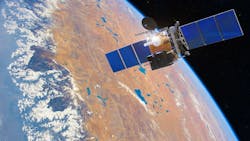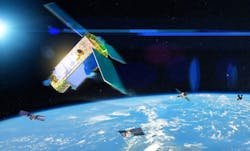LEOs Hold the Key to Satellite Broadband Connectivity
What you’ll learn:
- The rudiments of LEO constellations.
- How the space business is transitioning to support broadband infrastructure.
- Ground-station costs are falling, as is the cost of getting satellites in orbit.
Imagine a mega-constellation of thousands of tiny low-Earth-orbit (LEO) satellites blanketing the Earth and beaming broadband signals to populations in rural, remote, and underserved regions. From the mountains of Nepal to the plains of Africa, envision fast, reliable satellite broadband connectivity providing or improving digital access for millions of people.
Currently, the pricing structure of these networks is too expensive for most rural populations, and satellite broadband is limited to a few markets where terrestrial solutions don’t work. Although many uncertainties remain, costs will continue to evolve with technological advances and economies of scale. If constellation providers can offer competitive pricing, consumer demand could soar, and LEOs could bring access to satellite broadband connectivity across the globe.
While cable, fiber optic, and 5G mobile fuel the next generation of digital infrastructure on Earth, LEO satellite constellations are projected, in the long run, to play a key role in supporting the global connectivity ecosystem when fully operational. LEOs are expected to stimulate economic growth, improve access to education and healthcare, and help close the digital divide.
LEOs will expand high-speed internet access to landlocked developing countries, developing states, and hard-to-reach remote and rural areas. Island nations can be given a pathway via satellite to broadband internet and circumvent the enormous cost of building a submarine cable system carrying international traffic. Satellites can also provide backbone connectivity to mobile 5G cellular networks while enabling critical communication access for those most in need.
The Economics of Fiber Cable vs. Satellite
Providing broadband internet to millions of customers in a heavily populated urban environment is a lucrative business. However, building and maintaining terrestrial expansion to more sparsely populated regions is expensive. Return on investment rarely offsets the cost. Thus, terrestrial build-out to rural and remote areas can lag for years, even decades.
One funder of such efforts puts it this way: “For geographies without direct access to fiber-optic cable infrastructure or at great distances from high-capacity bandwidth, satellite connectivity is the only option available.”1
No matter the technology, there’s an infrastructure cost to build and operate the core network, ongoing customer equipment costs, and recurring subscriber costs for the customer.
Local, state, and national funding programs can help cover some terrestrial-based infrastructure costs and service plans. The FCC’s Affordable Connectivity Program, the USDA’s ReConnect Rural Broadband Program, and the U.S. Bipartisan Infrastructure Bill provide billions of dollars to individual states, operators for infrastructure expansion, and subsidy programs to low-income families. But the size and scope of the terrestrial-based plans are limited. Another, more comprehensive solution is needed.
LEO Constellations
Today, LEO satellites are the focus of intense interest and capital investment. Mega-constellations of up to 12,000 LEO satellites are in the early stages of deployment (Fig. 1). According to a 2020 analysis of the commercial space industry by McKinsey, current satellite internet proposals becoming a reality translates into about 50,000 active satellites orbiting overhead within 10 years.2
Recent statistics on satellites in operation:
- 90% of all satellites are LEOs
- 7,500 LEOs now circle Earth (as of September 2021)
- Orbit of 160 to 2,000 km (60X closer than geostationary equatorial orbits (GEOs))
- Orbit period of 88 to 127 minutes (depending on altitude)
Why So Many Satellites?
Low-Earth-orbit satellites pass overhead quickly, providing connectivity over a small geographic area for a brief time. The advantage of the LEO’s low orbit (2,000 km) vs. a geostationary Earth orbit (35,000 km) is lower latency and the subsequent reduction in the time it takes for a signal to travel round trip from ground to satellite and back down again.
A lower latency reduces lag and permits faster response times for communications. However, the current generation of satellite broadband will not support the 3GPP low-latency spec requirements needed for immersive gaming, video calls, streaming video, or much touted innovations such as remote robotic surgery and autonomous driving.
LEO constellations require an extensive network of hundreds or thousands of satellites to attain robust global coverage (Fig. 2). Rural and remote communities, the areas most targeted by the constellations, are often the least able to afford the cost of the satellite dish equipment and data plans. This necessitates government programs and subsidies as well as new business models that require deeper collaboration and standards, and interoperable, open architecture among all of the players.
Space Business in Transition
Today’s commercial space business is moving away from yesteryear’s low-volume, government-funded, one-off programs to large-scale commercial ventures employing reusable rockets and smaller, cheaper LEOs. The industry seeks adaptable and flexible solutions that are cost-effective and capable of meeting accelerated demand. New players, applications, business models, and government programs make possible a dynamic competitive commercial space ecosystem.
The commercial space satellite business is being driven by several market drivers and enabling technologies. Among the former are:
- Global coverage for rural, remote, and urban areas
- A drive to close the digital divide
- Lower launch and ground-station costs
- Smaller, lighter, and less-costly satellites
Enabling technologies that are in play include:
- Modern IC technology
- Advanced phased-array functionality
- Development of large mega-constellations
McKinsey’s analysis portends that “new satellite constellations are on the cusp of deployment, but their long-term success hinges on substantial cost reductions.”2
Advances in design, manufacturing, and standardization have had the most significant effect on the satellite industry, enabling faster and more flexible deployment. Whether costs ultimately come down enough to make satellite broadband connectivity affordable is still unclear.
Reusable Rockets and Smaller Satellites
LEO satellite launches are rapidly ramping up while costs continue to shrink. The decreased launch cost results from a vertically integrated launch vehicle production line that is more reliable, adaptable, and efficient. With the combined savings from ridesharing, booster reuse, and lower orbit satellite placement, the price per satellite for launch is now as little as $1 million (Fig. 3).
Tailoring Reliability and Rad-Hardening
High-reliability, radiation-tolerant semiconductors were initially required to survive for decades in the extreme conditions of space aboard NASA missions to the planets and high-Earth-orbit GEO satellites. But LEO satellite markets have relaxed requirements, with durations of only a few years and lower earth orbits with reduced levels of radiation exposure.
“Today’s high-volume commercial space market cannot afford, nor do they often require, the more costly 'classic' components,” said Chris Chipman, Product Line Director, Aerospace, Defense and RF Products, ADI. “They can realize cost savings with ADI’s commercial-off-the-shelf (COTS) components.”
Benefits include access to advanced technologies; higher levels of integration and performance; and superior size, weight, and power (SWaP). Commercial space low (CSL) grading offers testing and screening suitable for constellations orbiting in lower-radiation environments for those requiring more protection.
Reducing Ground-Station Costs
Ground stations form the core of global networks, and a satellite dish must be within 500 miles of a ground station to access the internet. Thus, an extensive network of internet-connected ground stations is required. Cutting the cost or the number of ground stations needed is critical for an industry on a mission to bring connectivity to underserved populations in rural and remote areas.
LEOs with laser links or optical intersatellite lasers (OISLs) can reduce the number of ground stations needed for global connectivity. Laser links distribute communication traffic and route it around a constellation—between satellites—rather than pinging back and forth between ground stations and space. The routed signal is sent directly to a home antenna.
Increasing Bandwidth and Opportunity
According to the 2021 Asian Development Bank report, “LEOs are forecasted to significantly increase the available internet bandwidth in remote and rural geographies not currently served by fiber-optic cables,”1 The increased bandwidth could increase economic and social development opportunities in those regions, provided that the private sector companies investing in LEO constellations have identified market opportunities that unlock long-term value to extend service to these regions.
Satellite Broadband Access Now and in the Future
Satellite networks can potentially extend the internet’s reach to places that conventional fixed and mobile networks can’t be or where terrestrial-based technologies aren’t economically viable.
Satellite broadband offers the promise of ubiquitous connectivity and new ways of working and living untethered from cable and fiber connections. Urban students, rural farmers, and people working in remote offshore mining rigs and ships at sea all stand to benefit. Service levels may eventually rival fiber-optic cable speed and latency, enabling new applications that are yet to be envisioned.
More than a dozen startups now plan to use small satellites (LEOs) to connect with the Internet of Things (IoT).3 GSMA Intelligence forecasts that IoT connections, both consumer and those used in industry, will reach almost 25 billion globally by 2025.4
What’s Needed and What to Expect
Space-based communications networks must integrate seamlessly with terrestrial networks to maximize their effectiveness. Significant investment is required in space communications technology and terrestrial wireline infrastructure between satellite ground stations, service providers, and data centers.
Given satellites’ power to transform the communications landscape and bridge the digital divide, internet providers, manufacturers, and companies from all walks of industry should consider how to prepare for the future today. They should also investigate how to best tap into opportunities presented by the new communications frontier.
References
1. John Garrity and Arndt Husar. “Digital Connectivity and Low Earth Orbit Satellite Constellations: Opportunities for Asia and the Pacific.” Asia Development Bank, April 2021.
2. Chris Daehnick, Isabelle Klinghoffer, Ben Maritz, and Bill Wiseman. “Large LEO satellite constellations: Will it be different this time?" McKinsey, May 4, 2020.
3. Christopher Mims. “Elon Musk and Amazon Are Battling to Put Satellite Internet in Your Backyard.” The Wall Street Journal, March 20, 2021.
4. Sylwia Kechich. “IoT Connections Forecast: The Rise of Enterprise.” GSMA, December 16, 2019.
About the Author
Joe Barry
Vice President, Wireless Communications, Analog Devices
Joe Barry is the Vice President of the Wireless Communications Business Unit at Analog Devices. He’s responsible for the wireless market segment, along with the technology groups of high-speed converters, SDR transceivers, and microwave communications. For more than 26 years, Joe has served in leadership roles in the wireless communications, consumer, and semiconductor industry.
He earned a B.Eng. in electrical and electronic engineering from University of Greenwich and an MBA from the University of Limerick. Joe holds five patents in analog and digital video and audio technologies.



